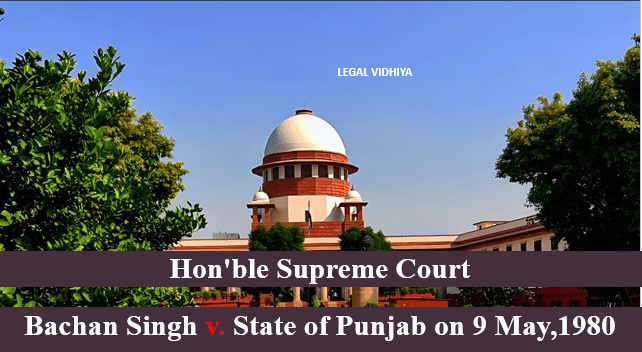
| CITATION | (1982) 3 SCC 24, 1983 1 SCR 145 a |
| DATE OF JUDGMENT | 9 May, 1980 |
| COURT | Supreme Court of India |
| APPELLANT | Bachan Singh |
| RESPONDENT | State Of Punjab |
| BENCH | A five-judge bench of the Supreme Court consisting of,justice Y.C. Chandrachud,justice A.Gupta,justice N. Untwalia,justice P.N Bhagwati,and justice R.Sarkaria. |
INTRODUCTION:
Bachan Singh v. State of Punjab is a landmark case in Indian constitutional law regarding the constitutionality of the death penalty. The case was heard by the Supreme Court of India and led to significant jurisprudential developments in the context of capital punishment.. It examined whether the death penalty was in consonance with the provisions of the Indian Constitution. In this case the Supreme Court announced significant limitations on the death penalty in this case by establishing the “rarest of the rare” doctrine. A genuine and abiding concern for the dignity of human life presupposes resistance to taking a life through the instrumentality of law,” the Supreme Court stated. That should be done only in the rarest or most rare cases where the alternative opinion is unquestionably foreclosed.”
BACKGROUND:
Bachan Singh v. State of Punjab was a landmark case heard by the Supreme Court of India in 1980. The case addressed the constitutionality of the death penalty in India, specifically whether it violated fundamental rights under the Indian Constitution.
FACTS:
In this case the appellant Bachan Singh,murdered her wife,and he was found guilty and sentenced to life in prison.After his release ,he lived with his cousin Hukam Singh and his family. Following that, Bachan Singh was charged, convicted, and sentenced to death for the murders of Desa, Durga, and Veeran.Bachan Singh, the appellant, was convicted under Section 302 of the Indian Penal Code (IPC) for committing murder. He was sentenced to death by the Sessions Judge, which was later confirmed by the High Court. Bachan Singh appealed to the Supreme Court.
PROVISIONS INVOLVED IN THE CASE:
Section 354 (3) of the CrPC, 1973.
Section 302 of the Indian Penal Code, 1860.
Article 14 and 21 of the Constitution.
ISSUE:
The primary issue in this case was whether the imposition of the death penalty under Section 302 of the Indian Penal Code was constitutionally valid, considering the rights enshrined in the Indian Constitution.
ARGUMENTS:
Appellant’s Argument: Bachan Singh’s counsel argued that the mandatory imposition of the death penalty violated fundamental rights, particularly the right to life and the prohibition of cruel and unusual punishment. It was contended that capital punishment should only be utilized in the rarest of rare cases, where the alternative of life imprisonment would be demonstrably inadequate.
State’s Argument: The state, representing the prosecution, contended that the death penalty was a necessary and justifiable punishment for particularly heinous crimes. They argued that it served as a deterrent and was a form of retribution.
JUDGEMENT:
On 9 May 1980, the Supreme Court of India rendered its judgment. The Court upheld the constitutional validity of the death penalty but introduced significant restrictions. It established the “rarest of rare” doctrine, asserting that capital punishment should only be applied in cases where the option of life imprisonment would be unquestionably insufficient.
Furthermore, the Court shifted the burden of proving that the death penalty was the only appropriate punishment to the prosecution. The judgment emphasized that sentencing judges must take into account both the nature of the crime and the characteristics of the offender when determining the punishment.
ANALYSING THE JUDGMENT:
CONSTITUTIONALITY OF THE DEATH PENALTY:
The central issue was whether the imposition of the death penalty under Section 302 of the Indian Penal Code was constitutionally valid.
The Court acknowledged the gravity of the death penalty, recognizing that it was the “rarest of rare cases” where it should be imposed.
RAREST OF RARE DOCTRINE:
The judgment introduced the concept of the “rarest of rare” doctrine, which stated that the death penalty should only be applied in exceptional cases where the alternative of life imprisonment would be demonstrably inadequate.
SHIFTED BURDEN OF PROOF:
The burden of proving that the death penalty was the only appropriate punishment was shifted to the prosecution. This meant that the prosecution had to establish that no punishment other than death would suffice.
CONSIDERATION OF CRIME AND CRIMINAL:
The judgment emphasized that sentencing judges must consider both the nature of the crime and the characteristics of the offender when determining the punishment.
Deterrence and Retribution:
While the state argued that the death penalty was a necessary deterrent and a form of retribution for heinous crimes, the judgment emphasized that deterrence alone could not justify capital punishment.
IMPACT:
Bachan Singh v. State of Punjab laid the foundation for the modern approach to the death penalty in India.
It influenced subsequent cases and legislative discussions on capital punishment.
SIGNIFICANCE:
The judgment balanced the interests of justice, retribution, and deterrence with the constitutional rights of the accused.
It recognized the sanctity of life and established strict criteria for the imposition of the death penalty.
CRITIQUES:
While the “rarest of rare” doctrine provided guidance, its application in practice has sometimes been criticized for inconsistency.
Debates on the efficacy and morality of capital punishment continue in India, with calls for its abolition.
CONCLUSION:
Bachan Singh v. State of Punjab represented a pivotal moment in Indian legal history, providing a framework for the judicious application of the death penalty. It highlighted the importance of balancing the severity of punishment with respect for fundamental rights, influencing subsequent jurisprudence and legislative discourse on capital punishment in India.
References
Written by Mita Sarker an intern under legal vidhiya




0 Comments